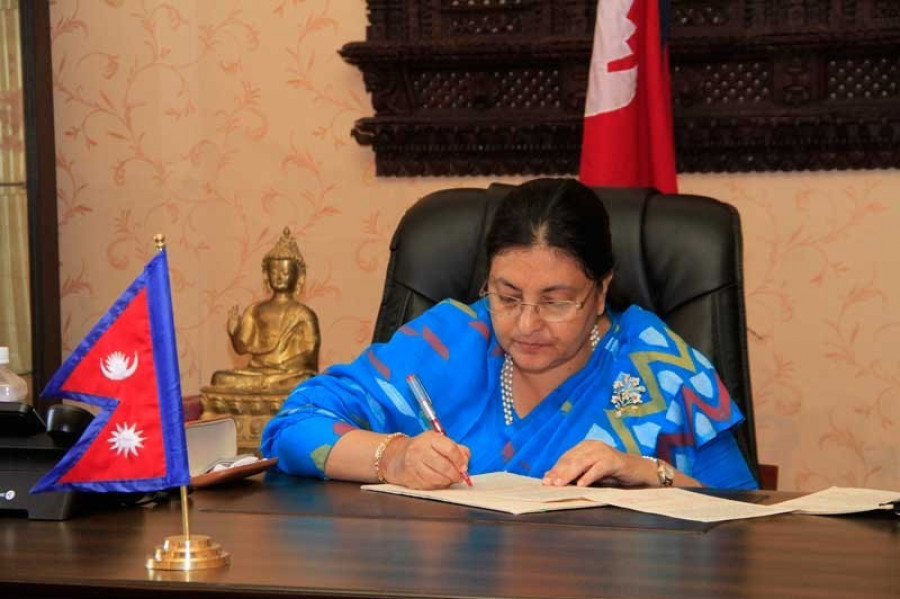Columns
Republicanism and presidency
Events of the past 15 years should provide valuable experience for the next President.
Achyut Wagle
President Bidya Devi Bhandari addressed a joint session of the federal Parliament on Friday, her last speech to the country's lawmakers before she leaves office at the end of two terms on March 12.
Bhandari is the second president of the republic of Nepal which was established by ousting the 240-year-long monarchical rule of the Shah dynasty in May 2008. She also holds the distinction of being Nepal's first woman president.
The Constitution of Nepal has essentially made the role of the President purely “ceremonial” without executive power. The main specified duty of the President is “to abide by and protect” the constitution. The key question here is whether Bhandari and her predecessor Ram Baran Yadav have acted in consonance with the true spirit of this constitutional expectation, or whether they have explicitly or implicitly harboured intentions to exercise executive power in the last 15 years of Nepal's republican history.
The first presidency
Nepal's first President Yadav oversaw two key political transitions in challenging times. First, he became the head of state amidst multiple apprehensions about how deposed king Gyanendra and his loyalists would react after the dethronement. Winning the confidence of the then “Royal” Nepal Army was critical since it was a force traditionally considered to be unflinchingly loyal to the Crown. Any unsupportive role by the military might have complicated or possibly derailed the transition from monarchy to republicanism.
Yadav saw seven changes in government during his tenure of as many years.
The second transition was the promulgation of the new constitution. The constitution drafting process dragged on for seven years despite the original mandate of completing the task in two years. The first Constituent Assembly was dissolved in 2013 without producing a constitution. Yadav promulgated the current constitution amidst violent resistance from Tarai-based political parties.
India, Nepal’s closest neighbour in every sense of the term, had strong reservations about the implementation of the new constitution. As a consequence, India imposed a five-month-long economic blockade against Nepal to show its displeasure.
Yadav demonstrated courage by promulgating the constitution on September 20, 2015 despite these oddities, and the fact that his fellow Madheshis had become highly restive. He later went on record stating that the constitution might never have been implemented had that opportunity been missed. He thought that any shortcoming, however grave, could be mended by future amendments. This indeed was great statesmanship on his part.
Yadav's greatest folly, comparable to overstepping the limits of a ceremonial president, was to foil the then (and current) Prime Minister Pushpa Kamal Dahal's attempt to sack Chief of Army Staff General Rookmangud Katawal on May 3, 2009. Dahal resigned the next day calling Yadav’s intervention an unconstitutional exercise of executive power. Years later, Dahal admitted in several public speeches that his inexperience in running the government had led to many faux pas, hinting that the Katawal episode too was perhaps an immature move.
Bhandari’s tenure
Bhandari has seen six governments since she became President, but she has been invariably seen acting at the behest or in the interest of CPN-UML chairman KP Sharma Oli. On two occasions, she swiftly upheld the then prime minister Oli's recommendations to dissolve the House of Representatives, even staying up till midnight waiting for the paperwork to be delivered.
Bhandari also issued two controversial ordinances amending the Political Party Act and the Constitutional Council Act, which allowed Oli, respectively, to continue in power and validate the council's decisions taken by a reduced number of members. But she was not so cooperative with regard to recommendations made by governments led by other parties, which gave rise to the Oli-Bhandari collusion hypothesis.
Her love for a pompous lifestyle and clumsy imitation of a “regal” demeanour were widely seen as being against what the public expected from the president of a new republic. Early this week, Nepali doctors disrupted health services across the country in protest against what they called police brutality against a colleague when the roads were being cleared for the President's motorcade. Instead of being apologetic for causing inconvenience to the public, Bhandari, in a television interview, defended it as “respect that VIPs deserved”.
Lately, she appears to be keen to retire as a President genuinely concerned about the betterment of the country, and has been putting her efforts into cultivating an image of a polished stateswoman. Her address to Parliament was an astute and undoubtedly a true reflection of seemingly irreversible economic woes and the crisis of governance in the country. The only question that will perhaps prop up is: Why didn’t she, instead of acquiescing to the mala fide intentions of several governments, admonish them if she had genuine concerns about the plight of the people?
Nevertheless, the successful completion of two tenures by two presidents each is, in itself, a matter of celebration. The 15-year-long republican history should definitely provide valuable experience for Nepal’s next President.




 11.12°C Kathmandu
11.12°C Kathmandu















